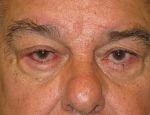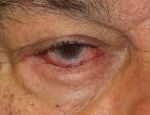Entropion Repair Surgery in Miami
Get your eyes free of discomfort and irritation.
Eyelid entropion is a medical condition that occurs when the lower or upper eyelid turns inward toward the eye. This causes the eyelashes to rub against the cornea, which can produce a great deal of discomfort and irritation.
Those over the age of 60 are particularly prone to developing entropion due to the weakening of the eyelid margin and the development of scar tissue around the eye area.
Symptoms of Entropion
Symptoms of Entropion include:
- Feeling like there’s something in the eye
- Redness of the eyes
- Tearing or watering of the eye
- Blurry vision
- Eye pain
- Itching
- Sensitivity to light and wind
- Drainage
- Crusting of the eyes
Entropion Risk Factors
Entropion can also lead to other more serious issues such as corneal ulcers, eye infections, and an increased risk factor of developing cataracts. To prevent these problems, it is important to have entropion surgically repaired.
Ectropion vs Entropion
Ectropion and entropion are two eyelid conditions that describe the way the eyelids turn, and they are similar to each other.
Ectropion – Eyelids turn out
Entropion – Eyelids turn in
The corrective procedures and symptoms for both types of malposition are similar. Entropion symptoms can be relieved with eye drops, botox, and surgery.
Causes
Entropion can be caused by:
- Inflammation. If your eyes feel dry or inflamed and you rub them or squeeze them shut to relieve the discomfort, it can cause spastic entropion. This is when the eyelid muscles spasm and the edge of the lid rolls inward against the cornea.
- Eye infection. Trachoma, an eye infection that can cause scarring of the inner eyelid and lead to entropion and blindness, is prevalent in several developing countries across Africa, Asia, Latin America, the Middle East, and Pacific Islands.
- Muscle weakness. The most common cause of entropion is the weakening of the muscles under your eyes and the stretching out of tendons that occurs as you get older.
- Scars or previous surgeries. Chemical burns, trauma, or surgery can cause scarring on the skin, which can alter the natural shape of the eyelid.
- Developmental complication. Entropion that occurs at birth (congenital) may be due to an additional skin fold on the eyelid that causes the lashes to turn inward.
How to relieve entropion?
Entropion can be relieved through several different methods. These include:
Artificial tears – Artificial tears or lubricants are used to provide a protective coating over the eye and reduce irritation.
Tarsal strip – A procedure where a small piece of tape is placed on the inner part of the eyelid to keep it from turning inward. This procedure is usually done in conjunction with botulinum toxin injections or other treatments.
Botulinum toxin injections – Botox temporarily paralyzes the muscle that causes entropion, allowing time for the eyelids to heal and realign naturally.
Surgery – Entropion repair surgery is typically recommended if other methods have not been successful in relieving symptoms or if entropion has been caused by scar tissue or the aging process.
Methods of Entropion
The procedure involves removing a small amount of the orbicularis oculi muscle and tightening it to prevent the eyelid from turning inwards. In most cases, the procedure is performed under local anesthesia and takes about an hour.
The recovery period may last up to two weeks, during which time it is important to rest and use artificial tears to lubricate the eye.
Surgical entropion repair methods include:
- Eyelid tightening. This procedure tightens your eyelid by shortening a strip of tissue called the lateral tarsus.
- Retractor reinsertion. This procedure tightens the muscle used to open and close your eyelid, known as the lid retractor.
Entropion Repair Surgery Results
Once the entropion repair surgery is complete, the eyelids should no longer be turning inward and symptoms of irritation or discomfort should become less noticeable.
While there is still a chance that entropion can reoccur, it is far less likely after this procedure. To keep your eyes healthy and feeling their best, it’s important to practice proper eye care.
Post-op Eye Care
Post-op eye care includes:
- Avoiding rubbing or touching the eyes
- Using artificial tears to lubricate and protect the eye from irritation
- Practicing good hygiene by washing your hands regularly
- Wearing sunglasses to protect the eyes from wind and dust
- Avoiding activities that may put pressure on the eyelids, such as swimming or using a sauna.
Entropion repair surgery is a safe and effective way to relieve discomfort caused by entropion. If you are experiencing symptoms of entropion, contact Dr. Myron Tanenbaum in Miami for more information on entropion repair surgery.


